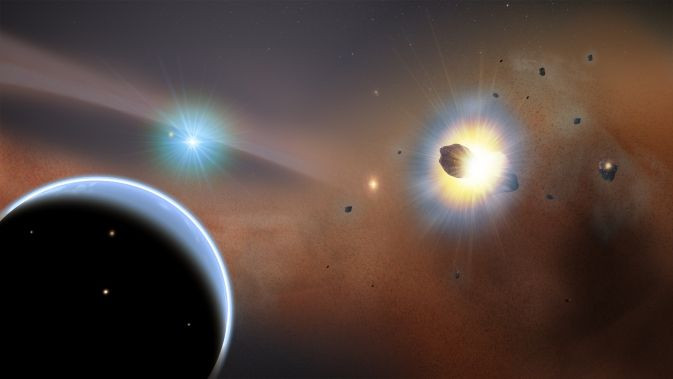Icy Debris From A Star In The Neighborhood Of The Solar System Suggests Existence Of New Planet

An international team of astronomers has found a swarm of icy, comet-like bodies in the solar system, which suggests the existence of an as-yet-unseen planet in Earth's cosmic neighborhood, NASA announced Thursday.
According to the space agency, astronomers exploring a disk of gas and dust around a nearby star uncovered a compact cloud of poisonous gas formed by constant collisions among the comet-like bodies. The astronomers suggest that the comet swarm is either the remnant of a crash between two icy worlds resembling Mars, or frozen debris trapped and concentrated by the gravity of an unknown planet.
The astronomers used the Atacama Large Millimeter Array, or ALMA, in Chile, to examine dust and carbon monoxide (CO) molecules in a disk surrounding the bright star, Beta Pictoris, which is only 20 million years old and is located about eight Astronomical Units, or AU (1 AU = 93 million miles) from Earth.
“Although toxic to us, carbon monoxide is one of many gases found in comets and other icy bodies,” Aki Roberge, an astrophysicist at NASA, said in a statement. “In the rough-and-tumble environment around a young star, these objects frequently collide and generate fragments that release dust, icy grains and stored gases.”
The images from ALMA reveal that a huge belt of carbon monoxide is located at the fringes of the Beta Pictoris system, with much of the gas concentrated in a single clump located about 8 billion miles from the star. According to astronomers, the presence of the gas is a clue that something interesting is going on.
According to astronomers, while further studies of the gas cloud will clarify the situation, current evidence favors two scenarios.
In the solar system, Jupiter's gravity has trapped thousands of asteroids in two groups, one leading and one following the planet as it travels around the sun. Similarly, a giant planet located in the outer reaches of the Beta Pictoris system could also hold comets in a pair of tight, massive swarms.
“Detailed dynamical studies are now under way, but at the moment we think this shepherding planet would be around Saturn's mass and positioned near the inner edge of the CO belt,” Mark Wyatt, an astronomer at the University of Cambridge in England, said in the statement.
The scientists said that a giant planet, with a mass several times greater than Jupiter, might have formed near the star and migrated outward as the disk underwent changes.
In an alternative scenario, scientists suggest that a crash between two Mars-sized icy planets about half a million years ago would account for the comet swarm, with frequent collisions among the fragments gradually releasing carbon monoxide gas.
A paper, related to the study, was published in Science Express on Thursday.
Check out the video here:
© Copyright IBTimes 2024. All rights reserved.






















